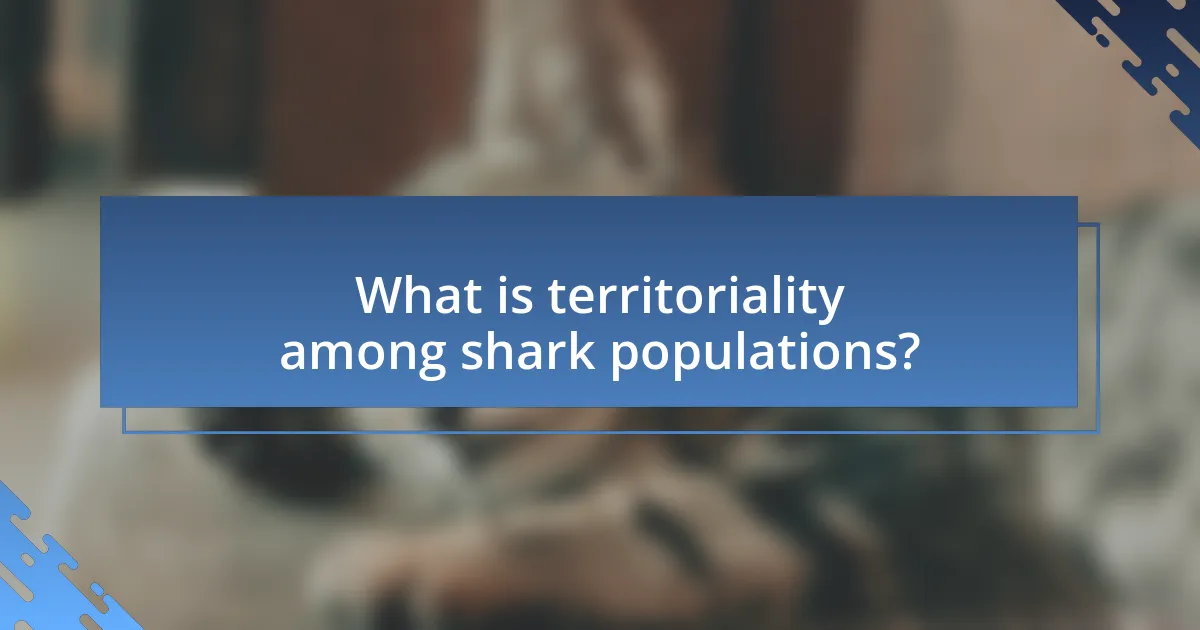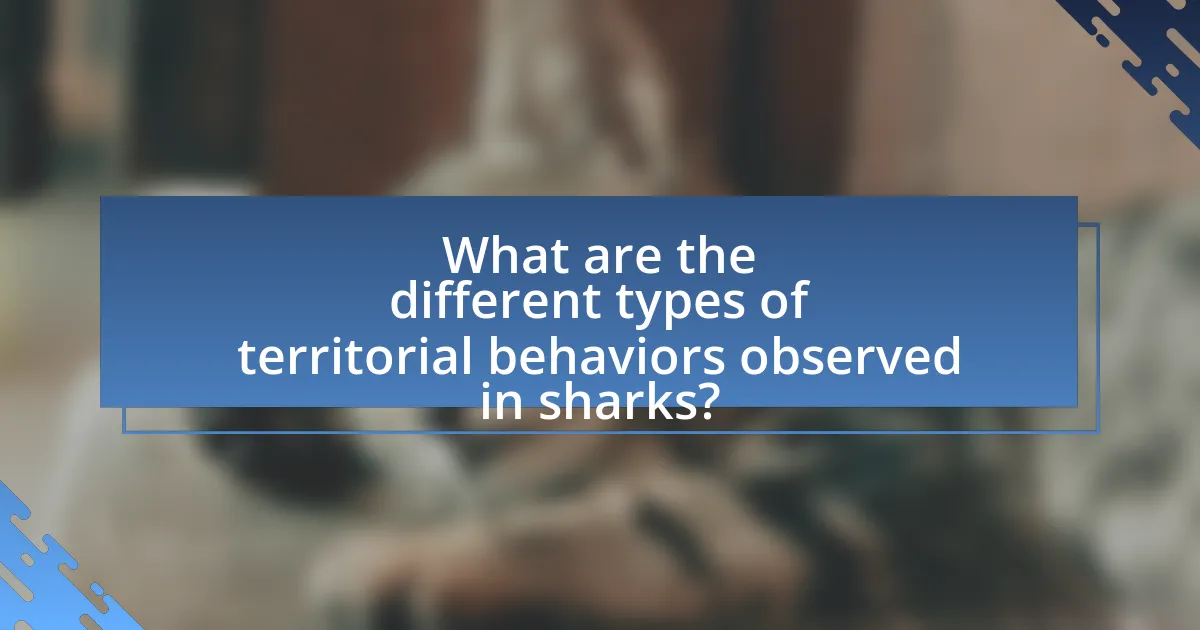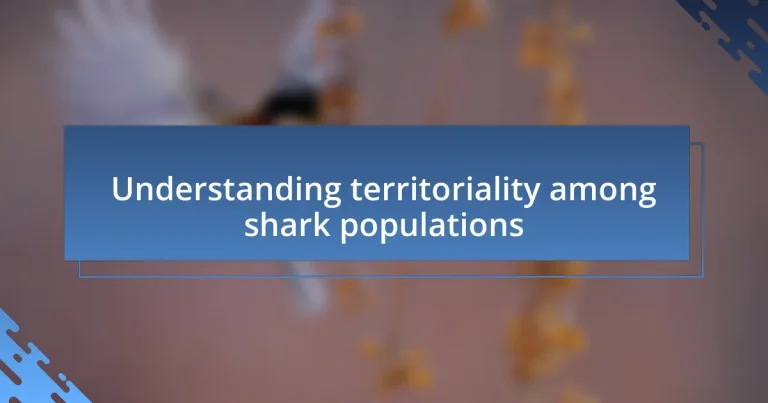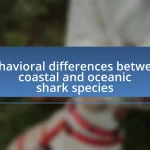Territoriality among shark populations refers to the behavior where individual sharks establish and defend specific areas within their habitat against intruders, significantly influencing their distribution and abundance. Key factors affecting territorial boundaries include resource availability, social hierarchy, and environmental conditions, which shape the spatial organization of shark populations. Various species exhibit distinct territorial behaviors, such as aggressive displays and patrolling, with differences observed between coastal and pelagic sharks. Human activities, including overfishing and habitat destruction, impact shark territoriality, prompting conservation efforts like marine protected areas to support their natural behaviors and populations. Understanding these dynamics is crucial for effective shark conservation and management strategies.

What is territoriality among shark populations?
Territoriality among shark populations refers to the behavior where individual sharks establish and defend specific areas within their habitat against intruders. This behavior is often observed in species such as the great white shark and the tiger shark, where males and females may claim territories for feeding, mating, or nursery purposes. Research indicates that territoriality can influence the distribution and abundance of shark populations, as individuals may engage in aggressive interactions to maintain their claimed areas, thereby impacting local ecosystem dynamics.
How do sharks establish territorial boundaries?
Sharks establish territorial boundaries primarily through behavioral displays and chemical signaling. These behaviors include aggressive posturing, vocalizations, and physical confrontations to deter intruders. For example, species like the great white shark exhibit territoriality by patrolling specific areas and engaging in displays of dominance, such as breaching or tail slapping. Additionally, sharks utilize olfactory cues to detect the presence of other sharks, which helps them identify and maintain their territory. Research indicates that these territorial behaviors are crucial for resource allocation, mating opportunities, and reducing competition among shark populations.
What factors influence the formation of these boundaries?
The formation of boundaries among shark populations is influenced by factors such as resource availability, social hierarchy, and environmental conditions. Resource availability, including food sources and breeding grounds, dictates where sharks establish territories to maximize their survival and reproductive success. Social hierarchy plays a crucial role, as dominant individuals may claim larger or more resource-rich areas, impacting the distribution of other sharks. Environmental conditions, such as water temperature, salinity, and habitat structure, also affect territorial behavior, as sharks may prefer specific areas that meet their physiological and ecological needs. These factors collectively shape the spatial organization and territoriality observed in shark populations.
How do environmental conditions affect shark territoriality?
Environmental conditions significantly influence shark territoriality by affecting their habitat preferences, resource availability, and social interactions. For instance, factors such as water temperature, salinity, and prey abundance can dictate the areas sharks occupy and defend. Research indicates that warmer waters can lead to increased metabolic rates in sharks, prompting them to expand their range in search of food, which may alter territorial boundaries. Additionally, studies have shown that changes in prey distribution due to environmental shifts can lead to increased competition among sharks, further impacting their territorial behaviors. For example, a study published in “Marine Ecology Progress Series” by Heupel and Simpfendorfer (2008) highlights how variations in environmental conditions can lead to changes in the spatial distribution of shark populations, thereby influencing their territoriality.
Why is territoriality important for shark populations?
Territoriality is important for shark populations because it helps maintain their social structure and resource availability. By establishing territories, sharks can secure access to essential resources such as food and breeding grounds, which are critical for their survival and reproductive success. Research indicates that territorial behavior can reduce competition among individuals, allowing for more stable populations. For instance, studies have shown that species like the great white shark exhibit territoriality, which correlates with higher reproductive rates and healthier populations. This behavior ultimately supports the ecological balance within marine environments, highlighting the significance of territoriality in sustaining shark populations.
What role does territoriality play in feeding and breeding?
Territoriality plays a crucial role in feeding and breeding among shark populations by establishing exclusive areas for resource access and reproductive activities. Sharks often defend specific territories to secure abundant food sources, which enhances their survival and reproductive success. For instance, studies have shown that species like the great white shark exhibit territorial behavior, particularly during breeding seasons, to protect their mating grounds from competitors. This behavior not only ensures that they have sufficient resources for themselves but also creates a safe environment for their offspring, thereby increasing the likelihood of successful breeding outcomes.
How does territoriality impact shark behavior and social structure?
Territoriality significantly influences shark behavior and social structure by establishing dominance hierarchies and influencing mating patterns. Sharks often defend specific areas to secure access to resources such as food and breeding grounds, which leads to aggressive interactions with intruders. For example, studies have shown that species like the great white shark exhibit territorial behavior, where dominant individuals maintain exclusive access to prime hunting areas, thereby affecting the distribution and social interactions of other sharks in the vicinity. This territoriality can result in structured social systems, where subordinate sharks may avoid certain areas to reduce conflict, ultimately shaping the overall dynamics within shark populations.

What are the different types of territorial behaviors observed in sharks?
Sharks exhibit several types of territorial behaviors, primarily including aggressive displays, patrolling, and marking of territory. Aggressive displays involve physical posturing and threats to deter intruders, which can be observed in species like the great white shark. Patrolling behaviors consist of sharks swimming along the boundaries of their territory to monitor for potential threats or competitors. Additionally, sharks may engage in marking territory through scent or physical alterations to the environment, such as biting or rubbing against structures. These behaviors are crucial for maintaining dominance and ensuring access to resources within their habitat.
How do various shark species exhibit territoriality?
Various shark species exhibit territoriality through behaviors such as marking their territory, aggressive displays, and defending specific areas from intruders. For instance, species like the great white shark and the tiger shark have been observed to establish and defend feeding grounds, often using physical aggression to deter competitors. Research indicates that territoriality can be linked to resource availability, with sharks displaying increased aggression in areas rich in prey. Additionally, studies have shown that certain species, such as the lemon shark, utilize specific habitats for breeding and will actively defend these areas against other sharks, reinforcing their territorial claims.
What are the differences in territoriality between coastal and pelagic sharks?
Coastal sharks exhibit more defined territoriality compared to pelagic sharks. Coastal sharks, such as the bull shark and tiger shark, often establish and defend specific areas, particularly around reefs and estuaries, where they find abundant food and breeding grounds. In contrast, pelagic sharks, like the great white and blue shark, tend to be more migratory and do not establish fixed territories, instead roaming vast oceanic areas in search of prey. Research indicates that coastal sharks may engage in aggressive behaviors to maintain their territories, while pelagic sharks rely on their mobility to exploit resources across larger distances.
How do juvenile and adult sharks differ in their territorial behaviors?
Juvenile and adult sharks exhibit distinct differences in their territorial behaviors. Juvenile sharks tend to have smaller home ranges and are often more transient, frequently moving between different areas in search of food and shelter, which reflects their need for growth and development. In contrast, adult sharks establish larger and more defined territories, often defending these areas from intruders, which is crucial for mating and feeding. Research indicates that adult sharks, such as the great white shark, can exhibit strong site fidelity, returning to specific locations for breeding or hunting, while juveniles may not show the same level of attachment to particular areas. This difference in behavior is influenced by factors such as size, maturity, and ecological roles within their environments.
What methods do researchers use to study shark territoriality?
Researchers use a combination of observational studies, telemetry, and genetic analysis to study shark territoriality. Observational studies involve direct monitoring of shark behavior in their natural habitats, allowing researchers to document interactions and movements that indicate territoriality. Telemetry, which includes the use of acoustic tags, enables scientists to track the movements of individual sharks over time, providing data on their range and patterns of space use. Genetic analysis helps in understanding population structure and dynamics, revealing how genetic diversity correlates with territorial behaviors. These methods collectively enhance the understanding of how sharks establish and maintain territories within their ecosystems.
How do tagging and tracking technologies contribute to our understanding?
Tagging and tracking technologies significantly enhance our understanding of shark populations by providing precise data on their movements, behaviors, and habitat use. These technologies, such as satellite tags and acoustic transmitters, allow researchers to monitor individual sharks over extended periods, revealing patterns of territoriality and migration. For instance, studies utilizing these technologies have shown that certain shark species exhibit site fidelity, returning to specific areas for feeding or breeding, which is crucial for conservation efforts. Additionally, data collected from these technologies can inform management strategies by identifying critical habitats and understanding the spatial dynamics of shark populations, ultimately contributing to more effective protection measures.
What role do observational studies play in analyzing shark behavior?
Observational studies are crucial in analyzing shark behavior as they provide direct insights into the natural activities and interactions of sharks in their habitats. These studies allow researchers to document behaviors such as hunting, mating, and territorial disputes in real-time, leading to a better understanding of social structures and territoriality among different shark populations. For instance, a study conducted by Heithaus et al. (2008) in Shark Bay, Australia, demonstrated how observational methods revealed the spatial dynamics and territorial behaviors of tiger sharks, highlighting the importance of habitat use in their social interactions. Such empirical evidence from observational studies is essential for developing effective conservation strategies and managing shark populations.

How does human activity influence shark territoriality?
Human activity significantly influences shark territoriality by altering their natural habitats and behaviors. Activities such as overfishing, habitat destruction, and pollution disrupt the ecological balance, leading to changes in shark distribution and territorial claims. For instance, overfishing reduces prey availability, forcing sharks to expand their territories in search of food, which can lead to increased competition among species. Additionally, coastal development and pollution can degrade essential habitats like nurseries, further impacting territorial behaviors. Research indicates that these human-induced changes can lead to shifts in shark populations, as seen in studies conducted by the University of Miami, which found that habitat loss directly correlates with altered movement patterns and territoriality in shark species.
What impact does fishing have on shark territorial behaviors?
Fishing significantly disrupts shark territorial behaviors by altering their natural habitats and reducing their populations. When fishing activities increase, sharks may experience heightened stress and displacement from their established territories due to overfishing and habitat degradation. Research indicates that the removal of apex predators like sharks can lead to changes in the ecosystem, affecting prey populations and further influencing territorial dynamics. For instance, a study published in the journal “Ecology Letters” found that areas with reduced shark populations saw an increase in smaller predatory fish, which in turn affected the distribution of other marine species. This evidence underscores the critical role fishing plays in modifying the territorial behaviors of sharks and the broader implications for marine ecosystems.
How does habitat destruction affect territoriality among shark populations?
Habitat destruction significantly disrupts territoriality among shark populations by altering their natural environments and reducing available resources. When habitats such as coral reefs and coastal areas are degraded, sharks may experience increased competition for limited space and food, leading to aggressive interactions and shifts in territorial boundaries. Research indicates that habitat loss can force sharks to expand their ranges or adapt to new territories, which can destabilize established social structures and mating patterns. For instance, studies have shown that in areas where habitats have been compromised, species like the blacktip reef shark exhibit changes in their territorial behaviors, often resulting in overlapping territories and increased conflict among individuals.
What are the consequences of pollution on shark territories?
Pollution negatively impacts shark territories by degrading their habitats and disrupting their food sources. Contaminants such as heavy metals, plastics, and chemicals can lead to habitat destruction, particularly in coastal areas where sharks breed and feed. For instance, studies have shown that pollutants can cause declines in prey populations, such as fish and crustaceans, which are essential for sharks’ survival. Additionally, pollution can lead to increased mortality rates in sharks due to bioaccumulation of toxins in their bodies, affecting their reproductive health and overall population dynamics. Research indicates that areas with high pollution levels often see a decrease in shark diversity and abundance, further illustrating the detrimental effects of pollution on their territories.
What conservation efforts are in place to protect shark territories?
Conservation efforts to protect shark territories include the establishment of marine protected areas (MPAs), regulations on fishing practices, and international agreements aimed at shark conservation. MPAs restrict human activities in designated regions, allowing shark populations to thrive and maintain their natural behaviors. For instance, the Shark Conservation Act of 2010 in the United States prohibits the practice of shark finning and promotes sustainable fishing practices. Additionally, the Convention on International Trade in Endangered Species (CITES) regulates the trade of shark species to prevent overexploitation. These measures are supported by scientific research indicating that protected areas can significantly enhance shark populations and biodiversity.
How do marine protected areas contribute to shark territoriality?
Marine protected areas (MPAs) enhance shark territoriality by providing a stable environment that supports their natural behaviors and habitat preferences. Within these designated zones, sharks experience reduced human disturbances, such as fishing and habitat degradation, which allows them to establish and maintain territories more effectively. Research indicates that MPAs can lead to increased shark populations and improved reproductive success, as evidenced by studies showing higher densities of sharks in protected areas compared to unprotected regions. This stability encourages sharks to exhibit territorial behaviors, as they can defend their space from competitors and access resources without the threat of human interference.
What policies are effective in mitigating human impact on shark populations?
Effective policies for mitigating human impact on shark populations include the establishment of marine protected areas (MPAs), regulations on shark fishing, and international agreements to combat illegal fishing. Marine protected areas, which cover significant portions of shark habitats, have been shown to increase shark populations by providing safe breeding and feeding grounds. For instance, a study published in the journal “Conservation Biology” found that MPAs can lead to a 50% increase in shark abundance within five years. Regulations on shark fishing, such as catch limits and bans on shark finning, help reduce overfishing and ensure sustainable populations. Additionally, international agreements like the Convention on International Trade in Endangered Species (CITES) play a crucial role in protecting vulnerable shark species by regulating trade and promoting conservation efforts globally.
What can individuals do to support shark territoriality and conservation?
Individuals can support shark territoriality and conservation by advocating for and participating in marine protected areas (MPAs). MPAs are designated regions where human activities are restricted to protect marine ecosystems, including shark habitats. Research indicates that MPAs can lead to increased shark populations and improved biodiversity, as they provide safe breeding and feeding grounds. For example, a study published in the journal “Marine Ecology Progress Series” found that sharks in protected areas showed a significant increase in abundance compared to unprotected areas. Additionally, individuals can reduce their carbon footprint to combat climate change, which negatively impacts shark habitats. Engaging in responsible seafood consumption by avoiding shark products and supporting sustainable fishing practices also contributes to shark conservation efforts.


